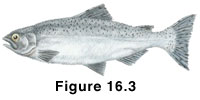 Description
DescriptionOncorhynchus tshawytscha (Chinook
Salmon)
(Other common names: Spring Salmon, King Salmon; Blackmouth Salmon)
Figure 16.3
 Description
DescriptionLength: 147 cm.
Mouth: large, terminal, directed forward; upper jaw extends beyond the posterior edge of orbit; snout is rounded; lips fleshy, teeth in jaws are sharp and movable; teeth also in premaxillaries, maxillaries, palatines, and the anterior region of the tongue; black colouration at the base of the teeth; teeth in spawning males become enlarged and hooked.
Body: elongate; caudal peduncle moderately compressed; caudal fin forked; adipose fin slender; 18-30 rough and widely spaced gill rakers over the first gill arch.
Color: green-blue to black on dorsal with large irregular black spots on upper side, the dorsal fine, and both lobes of the caudal fin; spawning individuals are olive to dark red or purple.
Depth: pelagic schooling; 0-200 m.
Habitat: open Pacific offshore waters, coastal streams.
Season: will enter spawning rivers throughout the year (see Hart, 1973) with some young moving out to sea immediately after hatch while some will stay in the river for up to one year. Young migrate northwards along the coast to feed, and some stocks will move offshore. Most return to spawn in their fourth or fifth year.
Diet: young/instream individuals will eat small crustaceans and invertebrates; young and adult/inshore individuals will eat crustaceans (e.g., copepods, euphasiids), forage fish species (e.g., herring, sand lance, pilchard).
Predators: larger fish species including other salmon (on young), sea birds, marine mammals, and terrestrial mammals.
Distribution: southern California to Alaska to the Bering Sea, to Kamchatka, and the Sea of Japan.
 Scale
Description
Scale
DescriptionRelative Size of Scale: large.
Position of Scales on Body: in rows above the lateral line canal 118-147; also on the lateral line canal 121-140 (Hart, 1973).
Overall Scale Shape: circular to somewhat oval anterior field, the posterior field is rounded, at times it can be irregular.
Focus and Circuli: focus is clearly defined and often not centralized between the fields; often just anterior to the interface of the posterior field and is approximately one-third the total scale length from the edge of the posterior field. The circuli are concentric with the scale outline. Circuli are generally continuous between the lateral and anterior fields, but a small number of discontinuous circuli may be present. The posterior field is clear.
Radii: radii absent. There are radial "striations" present (although these are not always apparent).
Remarks: Mosher (1969) indicated that if the freshwater nucleus is present it is small. The oceanic region has four to five winter marks with the first oceanic zone large; there are seven to eight complete circuli below the focus; strong radial striations are present; posterior field is clear but some circuli may enter; and reticulations are usually absent, but sometimes present in net-like formation. In contrast Bilton et al. (1964) cited considerable variation in this species with regard to the number of continuous and/or broken circuli that enter the posterior field.